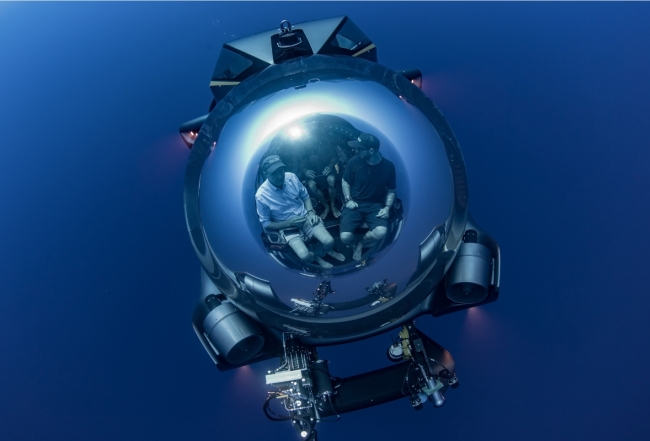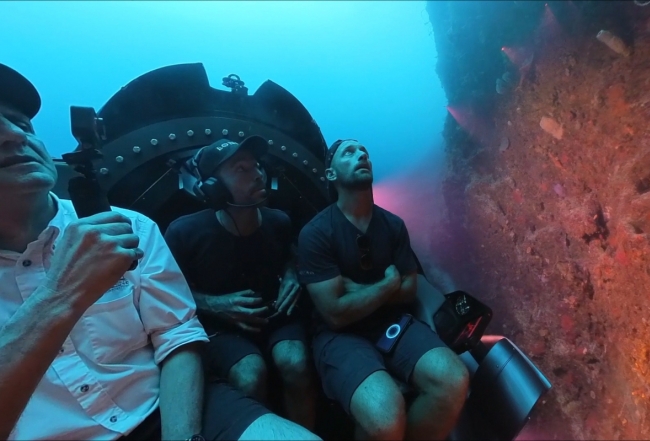The Surprising History of Superyacht Submarines
It was the end of a long day on the family’s dairy farm near Montreal in Quebec, Canada. A young Charles Kohnen had been hard at work milking cows, a core part of the family’s farming business.

Having completed the last of his tasks for the day, he walked into the family living room and turned on the TV. It was a moment that would change his life forever.
The rise and fall of manned submersibles
In the 1950s, 60s and 70s, the manned submersible industry was enjoying a boom period. With no other means by which to do underwater work, organisations relied on manned submersibles to carry out a large variety of subsea tasks.
But by the time the 1980s rolled around, all of that began to change. Rapid advances in electronic and computing technology opened the door for the emergence of Remotely Operated Vehicles (ROVs). Initially driven by high demand from the oil and gas industry as well as the defence industry, ROVs quickly replaced manned submersibles. Manned submersible operations saw an almost overnight decline along with the industry supporting it.
A crucial decision
He was nearing the end of his school career and Charles was facing a tough decision. He was a high achiever in his academic life, with an especially strong talent for math and physics. But he also had discovered an unusual love for art - but not just any art, as he fondly recalled. “Being raised on a dairy farm and milking cows every day, I started coming up with all these jokes and soon began drawing them into cartoons. Every day, I was drawing. Eventually, I won a competition to become a cartoonist for an agricultural trade magazine for the milk farmers of Quebec. And today, I’m still contributing a new cartoon for that magazine every month - 40 years later!”
One night in 1982, while milking the cows, Charles was wrestling with a decision about pursuing Engineering or Fine Arts after school. He was strong in math and physics, but given that he was now a published artist, he relished the idea of pursuing an art-related career.
With the milking now complete for the day, Charles settled down to watch some TV. “Star Trek was on TV,” he remembered. “There was this huge spaceship on screen. I looked at it and thought, “I want to build that!” And now I’m a published artist on the side as a hobby!” he exclaimed, chuckling.
The human platform re-emerges
Charles went on to enjoy a very successful engineering career working for oil and gas majors in locations all over the world. Then in 1995, he left all of that behind when he established SEAmagine together with his brother William - A NASA contractor - and was then quickly joined by Ian Sheard, a close friend with whom Charles had worked in the offshore oil sector.
During their market research, however, it soon became clear that it was impossible to buy a manned submersible. “They just didn’t exist,” said Charles. “Manned platforms had retired and there was no push to put humans underwater.”
However, the simultaneous rise of the internet convinced the SEAmagine team that the world was changing forever and with it, new opportunities were surely on the horizon. “It was clear to us that the underwater world would not be left untouched. But since the manned industry’s retirement, nobody had thought about revisiting the underwater world nor had they looked at a better way of getting there versus the way it had been done in the 1950s-70s” he commented.
The human experience underwater
And to be frank, the first generation of manned submersibles was hardly appealing or comfortable. They were extremely utilitarian. Most were designed with engineering imperatives as the main priority and the comfort and enjoyment of their human occupants a very distant second. A sub was typically an ugly metal hull containing small portholes through which the underwater world could - uncomfortably, and with some contortion - be viewed. Being neutrally buoyant, these subs also floated at the water’s surface when not diving, making them impossible to board while in the water, and difficult to deploy altogether. Thus, with passengers already onboard, the sub had to be hoisted via crane from the deck of its mothership, overboard and into the water. It was a risky, complex, time-consuming, and difficult operation requiring a large, skilled crew of dozens.
Charles and his co-founders knew that if they were to be successful, the whole process of using a submersible - the whole experience - had to be better. “We began by making the human experience of using a submersible, the centre of the design process, as opposed to making a vehicle and then shoehorning humans into it. We decided to forget about portholes. And that’s ultimately how we championed the full acrylic hull for a fully immersive experience underwater.”
Bringing subs to yachts
The SEAmagine team designed their new sub starting “with a blank sheet of paper”, and focused on a simple goal: “We’re going down to discover the underwater world and explore it!” Charles said.
But first, they had to solve a key challenge. “From the beginning, the question we asked was, ‘Why can’t we just launch a sub like a tender, with nobody in it, from onboard a yacht?’ Additionally, we knew we had to design the sub to float above the water so that passengers could easily access it and safely board it while the sub was already in the water.”
This challenge was soon solved and SEAmagine accordingly unveiled its first submersible in 1995. It was an unmitigated triumph of engineering and design. “The practicality of our sub changed the purpose of today’s submersibles forever,” he revealed. “It meant that all of a sudden, you no longer needed a huge research ship and a crew of 50 to launch your submersible.”
Takeoff in tourism
There was just one last problem: “There was no market looking to buy subs,” Charles admitted. “There was no demand that we were answering with our product. We had hoped, however, that if we build it, we will inspire people to revisit the human platform as a viable option both for leisure and research.”
Somewhat unexpectedly, SEAmagine’s first orders came from the tourism industry, and it was a market that SEAmagine not only embraced but served with excellent products delivering a superb experience to their occupants. “They were operating every day so these subs had to be reliable and very robust,” said Charles. “They were doing up to eight dives per day, and the experience we gained from the tourism industry helped us further evolve our designs into a very practical, safe and reliable product.”
SEAmagine’s early success in the tourism market in the late 1990s and early 2000s ultimately brought the company’s products to the attention of the scientific community but for a surprising reason.
Remotely operated restrictions
“The scientific community were frustrated by the limitations of ROVs,” Charles noted. Famed Texan marine archaeologist Dr George Bass liked SEAmagine’s submarines so much that, with Dr Bass’ backing, it led to SEAmagine producing the first submarine for the illustrious Institute of Nautical Archaeology.
That development opened up expedition tourism - a valuable new market - for SEAmagine’s products. By 2004, SEAmagine had produced the world’s first 3-person acrylic submersible. While the passenger capacity of its subs grew, the company’s subs were now also becoming capable of deeper trips.
An octopus but it’s a yacht
The superyacht industry had initially not shown much interest in SEAmagine’s subs, partly for practical reasons. Mainly, superyachts were in general simply not big enough yet to accommodate a private submersible. That began to change, however, when the now-famous superyacht Octopus was launched in 2003. “Before that, an 80m yacht was seen as insane. But following Octopus’ arrival, we started getting phone calls from captains and other parties. That made us start paying attention to the yachting sector, and we delivered our first yacht submarine in 2006. That’s when the yachting sector, with all of these now larger yachts with their evolving purposes, began emerging,” Charles recalled.
A poignant moment
SEAmagine’s subs have enabled owners and tourists across the world to have all kinds of unforgettable experiences under the sea. But for Charles, one story in particular stands out.
“Several decades ago, around the 1950s, a ship had sunk in western Australia and claimed the lives of many people on board. One of our clients, a documentary filmmaker, offered to take the sister of one of the wreck’s victims - also her sister - down to visit the wreck. The surviving sister had always imagined her sibling’s final resting place to be a deep, dark ocean floor. Well, they arrived at the wreck and now - decades after the tragedy - it was a garden full of fish and sea life; an abundance of living sea life that had grown over the whole wreck. When she saw the beautiful colourful living garden at the wreck, it completely changed - for the better - the lady’s perspective on her sister’s death and resting place.”
The thrill of the dive
Despite having personally completed approximately 1,000 dives on his company’s submarines, Charles was emphatic that his favourite part of the job remains diving on SEAmagine submersibles. “It’s the most exciting part of what I do. Not simply diving, but diving where we’ve never been. It’s the coolest experience ever. Sometimes you don’t find anything noteworthy, but sometimes what you find simply blows you away.
“After over 29 years and close to 1,000 dives, I’ve found that the moment you go deeper than 100 metres, nobody knows anything about what happens there, including the scientific community. I’ve lost count of the number of times that we’ve taken photos of sea life with phones and sent it to the university for identification and even they don’t know what we photographed!”

He explained that for private submarine owners to get similar maximum benefits from their submersibles, better expedition planning is required. “You can’t just show up somewhere, put the sub overboard and expect to see something memorable,” Charles said. “Effective use of subs in the yachting sector requires ensuring that the use of the sub is not an afterthought in the yacht’s destination planning. Therefore, the yachting industry could do a better job of properly managing and planning the locations at which the yacht will spend its time,” he continued.
“You don’t make dreams come true simply by having a submarine on board! It’s a magical, unique machine that requires effort from captains, crew and agencies to use effectively. The ‘Wow!’ factor happens once the expedition has been planned, organised and executed at the right location. Making dreams happen like that is very special!”
Read Next
Behind the Lens: The Underwater World of Didier Noirot
Exceptional Underwater Adventures With Rodolphe Holler
Pura Vida: Adventure Calls in Costa Rica














